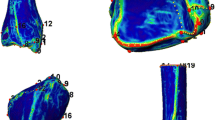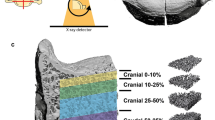Abstract
Bone mass and microarchitecture are the main determinants of bone strength. Three-dimensional micro-computed tomogrpahy has the potential to examine complete bones of small laboratory animals with very high resolution in a non-invasive way. In the presented work, the proximal part of the tibiae of hindlimb unloaded and control rats were measured with 3D MicroCT, and the secondary spongiosa of the scanned region was evaluated using direct evaluation techniques that do not require model assumptions. For determination of the complete bone status, the cortex of the tibiae was evaluated and characterised by its thickness. It is shown that with the proposed anatomically conforming volume of interest (VOI), up to an eight-fold volume increase can be evaluated compared to cubic or spherical VOIs. A pronounced trabecular bone loss of −50% is seen after 23 days of tail suspension. With the new evaluation techniques, it is shown that most of this bone loss is caused by the thinning of trabeculae, and to a lesser extent by a decrease in their number. What changes most radically is the structure type: the remaining bone is more rod-like than the control group's bone. Cortical bone decreases less than trabecular bone, with only −18% after 23 days.
Similar content being viewed by others
References
Birkenhäger-Frenkel, D. H., Coupron, P., Hüpscher, E. A., Clermonts, E., Coutinho, M. F., Schmitz, P. I. M., andMeunier, P. J. (1988): ‘Age-related changes in cancellous bone structure a two-dimensional study in the transiliac iliac crest biopsy sites’,Bone Min.,4, pp. 197–216
Bonse, U., Busch, F., Günnewig, O., Beckmann, F., Pahl, R., Deeling, G., Hahn, M., andGraeff, W. (1994): ‘3D computed X-ray tomography of human cancellous bone at 8 μm spatial and 10−4 energy resolution,Bone Min.,25, pp. 25–38
Feldkamp, L. A., Goldstein, S. A., Parfitt, A. M., Jesion, G., andKleerekoper, M. (1989): ‘The direct examination of three-dimensional bone architecture in vitro by computed tomography’,J. Bone Min. Res.,4, pp. 3–11
Goulet, R. W., Goldstein, S. A., Ciarelli, M. J., Kuhn, J. L., Brown, M. B., andFeldkamp, L.A. (1994): ‘The relationship between the structural and orthogonal compressive properties of trabecular bone.J. Biomech.,27, pp. 375–389
Harrigan, T. P., andMann, R. W. (1994): ‘Characterization of microstructural anisotropy in orthotropic materials using a second rank tensor’,J. Mater. Sci.,19, pp. 761–767
Hildebrand, T., andRügsegger, P. (1997a): ‘A new method for the model independent assessment of thickness in three-dimensional images’,J. Microsc.,185, pp. 67–75
Hildebrand, T., andRügsegger, P. (1997b): ‘Quantification of bone microarchitecture with the structure model index’,Comput. Meth. Biomech. Biomed. Eng.,1, pp. 15–23
Hildebrand, T., Laib, A., Ulrich, D., Kohlbrenner, A., andRügsegger, P. (1977c): ‘Bone structure as revealed by microtomography’,Proc. SPIE,3149, pp. 34–43
Hil'debrand, T., Laib, A., Müller, R., Dequeker, J., andRügsegger, P. (1999): ‘Direct 3D morphometric analysis of human cancellous bone: microstructural data from spine, femur, iliac crest; and calcaneus’,J. Bone Miner: Res.,14, 1167–1174
Hipe, J.-A., Jansujwicz, A., Simmons, C. A., andSnyder, B. (1996): Trabecular bone morphology from micro-magnetic resonance imaging’,J. Bone. Miner. Res.,11, pp. 286–297
Kapadia, R. D., Stroup, G. B., Badger, A. M., Koller, B., Levin, J. M., Coatney, R. W., Dodds, R. A., Liang, X., Lark, M. W., andGowen, M. (1998): ‘Applications of micro-CT and MR microscopy to study pre-clinical models of osteoporosis and osteoarthritis’,Technol. Health Care,6, pp. 361–372
Kleerekoper, M., Villanueva, A. R., Stanciu, J., Rao, D. S., andParfitt, A. M. (1985): ‘The role of three-dimensional trabecular microstructure in the pathogenesis of vertebral compression fractures’,Calcif. Tissue Int.,37, pp. 594–597
Kinney, J. H., andNichols, M. C. (1992): ‘X-ray tomographic microscopy (XTM) using synchrotron radiation’,Annu. Rev. Mater. Sci.,22, pp. 121–152
Kinney, J. H., Ryaby, J. T., Haupt, D. L., andLane, N. E. (1998): ‘Three-dimensional in vivo morphometry of trabecular bone in the OVX rat model of osteoporosis’,Technol. Health Care,6, pp. 339–350
Kohlbrenner, A., Hämmerle, S., Laib, A., Koller, B., andRügsegger, P. (1999): ‘Fast 3D multiple fan-beam CT systems’,Proc. SPIE,3772, pp. 44–54
Li, X. J., Jee, W. S. S., Chow, S-Y., andWoodbury, D. M. (1990): ‘Adaptation of cancellous bone to aging and immobilization in the rat: a single photon absorptiometry and histomorphometry study’,Anat. Rec.,227 pp. 12–24
Lorensen, W. E., andCline, H. E. (1987): ‘Marching Cubes: A high resolution 3D surface construction algorithm’,Comput. Graphics,21, pp. 163–169
Maeda, H., Kimmel, D. B., Raab, D. M., andLane, N. E. (1993): ‘Musculoskeletal recovery following hindlimb immobilization in adult female rats,Bone,14, pp. 153–159
Majumdar, S., Newitt, D., Mathur, A., Osman, D., Gies, A., Chiu, E., Lotz, J., Kinney, J., andGenant, H. (1996): ‘Magnetic resonance imaging of trabecular bone structure in the distal radius: relationship with x-ray tomographic microscopy and biomechanics,’ Osteoporosis Int.,6, pp. 376–385
Morey, E. R. (1979): ‘Spaceflight and bone turnover correlation with a new model of weightlessness’,Bio. Sci.,29, pp. 168–172
Mosekilde, L. (1995): ‘Asessing bone quality—animal models in preclinical osteoporosis research,Bone,17, pp. 345S-352S
Münch, B. (1991): ‘3D-Analyse von Knietomogrammen’. Diss. ETH Zuerich Nr. 9459
Odgaard, A., andGundersen, H. J. G. (1993): ‘Quantification of connectivity in cancellous bone, with special emphasis on 3D reconstructions’,Bone,14, pp. 173–182
Odgaard, A. (1997): ‘Three-dimensional methods for quantification of cancellous bone architecture’,Bone,20, pp. 315–328
Parfitt, A. M., Mathews, C. H. E., Villanueva, A. R., Kleerekoper, M., Frame, B., andRao, D. S. (1983): ‘Relationships between surface, volume, and thickness of iliac trabecular bone in aging and in osteoporosis’,Calcif. Tissue Int.,72, pp. 1396–1409
Parfitt, A. M. (1992): ‘Implications of architecture for the pathogenesis and prevention of vertebral fracture’,Bone,13, pp. S41-S47
Peyrin, F., Salome, M., Cloetens, A. M., Laval-Jeantet, A. M., Ritman, E., andRügsegger, P. (1998): ‘Micro-CT examinations of trabecular bone samples at different resolutions: 14, 7 and 2 micron level’,Technol. Health Care.,6, pp. 391–401
Riggs, B. L., Hodgson, S. F., O'Fallon, W. M., Chao, E. Y., Wahner, H. W., Muhs, J. M., Cedel, S. L., andMelton, J. M. (1990): ‘Effect of fluoride treatment on the fracture rate in postmenopausal women with osteoporosis’,New Engl. J. Med.,332, pp. 802–809
Rügsegger, P. (1996a): ‘Bone density measurement’ in Bröll, H., and Dambacher, M. A., (Eds): ‘Osteoporosis: A guide to diagnosis and treatment. Rheumatology’. Basel, Karger,18, pp. 103–116
Rügsegger, P., Koller, B., andMüller, R. (1996b): ‘A microtomographic system for the non-destructive evaluation of bone architecture’,Calcif. Tissue Int.,58, pp. 24–29
Simmons, C. A. andHipp, J. A. (1997): ‘Method-based differences in the automated analysis of the three-dimensional morphology of trabecular bone’,J. Bone Miner: Res.,12, pp. 942–947
Snyder, B. D., Piazza, S., Edwards, W. T., andHayes, W. C. (1993): ‘Role of trabecular morphology in the etiology of agerelated vertebral fractures’,Calcif. Tissue Int.,53, pp. S14-S22
Turner, C. H., Rho, J. Y., Ashman, R. B., andCowin, S. C. (1988): ‘The dependence of elastic constants of cancellous bone upon structural density and fabric’,Trans. Orthopaed. Res. Soc.,13, pp. 74
Ulrich, D., Van Rietbergen, B., Laib, A., andRügsegger, P. (1999): ‘The ability of 3D structural indices to reflect mechanical aspects of trabecular bone,Bone.,25, pp. 55–60
Van Rietbergen, B., Majumdar, S., Pistoia, W., Newitt, D. C., Kothari, M., Laib, A., andRügsegger, P. (1998): ‘Assessment of cancellous bone mechanical properties from micro-FE models based on micro-CT, pQCT and MR images’,Technol. Health Care.,6, pp. 413–420
Whitehouse, W.J. (1974): ‘The quantitative morphology of anisotropic trabecular bone’,J. Microsc.,101, pp. 153–168
Author information
Authors and Affiliations
Corresponding author
Rights and permissions
About this article
Cite this article
Laib, A., Barou, O., Vico, L. et al. 3D micro-computed tomography of trabecular and cortical bone architecture with application to a rat model of immobilisation osteoporosis. Med. Biol. Eng. Comput. 38, 326–332 (2000). https://doi.org/10.1007/BF02347054
Received:
Accepted:
Issue Date:
DOI: https://doi.org/10.1007/BF02347054




